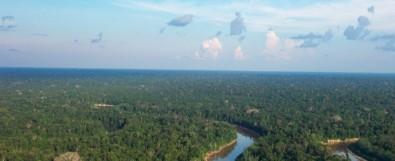Study reinforces the Amazon forest's importance in regulating atmospheric chemistry

Airborne measurements made as part of the GOAmazon scientific campaign show that the Amazon rainforest emits three times more isoprene than was previously estimated. photo: GOAmazon
According to Paulo Artaxo, Full Professor at the University of São Paulo's Physics Institute (IF-USP) in Brazil and a co-author of the study, isoprene is one of the main precursors of ozone in the Amazon, and it indirectly influences the balance of greenhouse gases in the atmosphere.
“The discovery explains a number of puzzles, such as the high concentration of ozone found downwind of Manaus that couldn't be due to anthropic action,” said Artaxo, principal investigator for the FAPESP-funded Thematic Project “GOAmazon: interactions of the urban plume of Manaus with biogenic forest emissions in Amazonia”.
Launched in 2014, GOAmazon is investigating the effects of urban pollution from Manaus on cloud formation in the Amazon, among other phenomena. The project also aims to extend knowledge of rain formation processes and the dynamics of interaction between the Amazon's biosphere and the atmosphere. Scientists plan to use the findings to estimate future changes in the region's radioactive balance, energy distribution and climate, as well as the impact of all these factors on global climate change.
Previous estimates were based on measurements made using satellites or forest towers up to 60m in height. During the GOAmazon scientific campaign, however, it was possible to collect new data using the Grumman Gulfstream-1, a research aircraft capable of flying at 6,000m, or nearly 20,000ft, and owned by the Pacific Northwest National Laboratory (PNNL) in the United States.
The airborne measurements were made in 2014 and 2015 during both the rainy and the dry seasons; the measurements were subsequently compared with data collected at ground level.
“With measurements taken at 4,000m, it was possible to calculate the average emission for a much larger area than those considered in previous research,” Artaxo said. “As a result, we could see that natural biogenic emissions are far greater than we supposed.”
The researchers made another discovery that they consider “surprising”: isoprene emissions vary sharply with terrain elevation and increase at higher altitudes. At a terrain elevation of 30m, for example, the isoprene emission flux was 6 milligrams per square meter per hour (mg/m2/h), while at an elevation of 100m, it was about 14 mg/m2/h.
“The Brazilian Amazon region is mostly low elevation. In the areas overflown by the research aircraft, there were minor terrain undulations, and we were able to observe a significant increase in emissions in the higher areas,” Artaxo said.
The researchers are not yet confident that they can fully explain this variation in emissions, which they observed during both the wet and the dry seasons. Their article proposes two hypotheses, which will need to be tested in future experiments.
One of the possibilities is that plant species in low-lying areas, which are often waterlogged, are different from those found at higher altitudes; isoprene emission levels may vary according to the predominant plant species.
The other hypothesis is that, at higher elevations, plants release more isoprene in response to water stress (because there is less water at higher elevations).
“Although it rains a lot in Amazonia, studies have shown that, in some areas, the water table falls well below the surface in the dry season. There are plants with very deep roots, capable of collecting water 10-20m underground,” Artaxo said.
Isoprene is one of the volatile organic compounds (VOCs) naturally emitted by vegetation in the Amazon. Along with other VOCs, it is a source of the secondary organic aerosols that form cloud condensation nuclei and that help to regulate the hydrologic cycle in the region.
Isoprene decomposition in the atmosphere gives rise to various byproducts, such as hydroxyl radicals (OH). Under certain conditions, this molecule reacts with atmospheric oxygen (O2) to form ozone (O3), one of the gases responsible for the greenhouse effect. High concentrations of ozone can irritate plant stomata, the pores used in gas exchange and transpiration. Irritation of the stomata hinders photosynthesis and the assimilation of carbon by plants.
“Furthermore, hydroxyl radicals control atmospheric oxidation of methane, another important greenhouse gas,” Artaxo said. “Depending on the situation, these OH radicals can prolong or shorten the half-life of methane, with implications for the balance of greenhouse gases.”
According to Artaxo, the Amazon forest was already considered the world's largest source of isoprene even before these new discoveries. “These findings reinforce the importance of this ecosystem to the regulation of the planet's tropical atmospheric chemistry,” he said. “Now, we need to include the results in global climate models to see exactly what effect these new values for isoprene emissions have on the climate.”
###
The GOAmazon consortium is funded by the US Department of Energy (DoE), FAPESP, and the Amazonas State Research Funding Agency (FAPEAM), among other partners.
Media Contact
All latest news from the category: Earth Sciences
Earth Sciences (also referred to as Geosciences), which deals with basic issues surrounding our planet, plays a vital role in the area of energy and raw materials supply.
Earth Sciences comprises subjects such as geology, geography, geological informatics, paleontology, mineralogy, petrography, crystallography, geophysics, geodesy, glaciology, cartography, photogrammetry, meteorology and seismology, early-warning systems, earthquake research and polar research.
Newest articles

A ‘language’ for ML models to predict nanopore properties
A large number of 2D materials like graphene can have nanopores – small holes formed by missing atoms through which foreign substances can pass. The properties of these nanopores dictate many…

Clinically validated, wearable ultrasound patch
… for continuous blood pressure monitoring. A team of researchers at the University of California San Diego has developed a new and improved wearable ultrasound patch for continuous and noninvasive…

A new puzzle piece for string theory research
Dr. Ksenia Fedosova from the Cluster of Excellence Mathematics Münster, along with an international research team, has proven a conjecture in string theory that physicists had proposed regarding certain equations….



